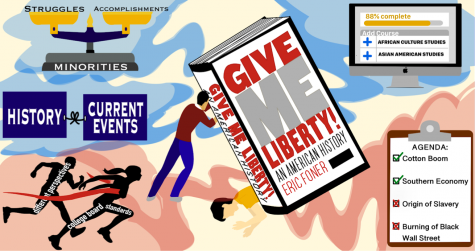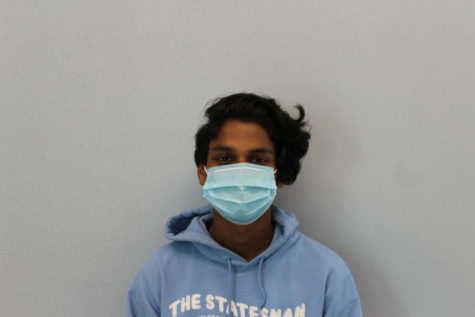It’s No Mystery: We Must Stop Avoiding the Intricacy in History
Statesman urges a more encompassing, current history curriculum despite possible challenges
 History classes consist of more than just the stereotypical memorization of dates and monotonous lectures; instead, they educate students on underlying political arrangements, economic conditions and power relations that have sculpted the backbone of modern society. However, as a growing number of voices finally came to the forefront of mainstream media last summer due to the Black Lives Matter movement, it has become apparent that certain, equally important historical perspectives fail to appear in our school curriculums.
History classes consist of more than just the stereotypical memorization of dates and monotonous lectures; instead, they educate students on underlying political arrangements, economic conditions and power relations that have sculpted the backbone of modern society. However, as a growing number of voices finally came to the forefront of mainstream media last summer due to the Black Lives Matter movement, it has become apparent that certain, equally important historical perspectives fail to appear in our school curriculums.
Although Statesman acknowledges that changing curriculums in AP classes may present certain challenges, it is paramount for the Social Studies Department to ensure that previously underappreciated viewpoints of history are presented equally.
For example, the World History and Geography course, a Stevenson graduation requirement, does very little to live up to the promise of its name. Though European history is covered in vast detail, the coverage of Asian and African history pales in comparison while Native American civilizations are almost completely ignored.
On a similar note, Statesman feels that U.S. history classes at Stevenson fail to fully address the true breadth of the experiences of people of color. While the cotton boom of the Southern economy and the key inventions that made it possible are covered in depth, little detail is given about the slaves on whose backs this prosperity was built, dehumanizing their experience and erasing a key perspective of history.
This pattern only continues into the early 20th century with the burning of Black Wall Street in 1921 by a white mob, an event that is covered in only one sentence of the AP United States History (APUSH) textbook, “Give Me Liberty!” and gets brushed past in the classroom, despite being cited by most scholars as a key event in history. Furthermore, in its brevity, the focus remains on the destruction it caused, but fails to mention the motives of the assailants. In doing so, the fact that the black families’ growing wealth and success in the Greenwood District, where many earned more than the minimum wage of today, enraged the attackers instead of an alleged inferiority, is completely missed, drastically changing our perception of the event.
As a result, Statesman urges such details not to be abandoned in the past; only focusing on the hardships of minorities, while simultaneously discussing the triumphs of white people, paints a picture of inferiority. Instead, allowing students to see discriminated groups fight against the odds of society to ultimately succeed would display the incredible feats of resilience of these people, and provide a beacon of hope to those that face similar challenges today.
Additionally, Statesman feels that the curriculum must consistently be tied back to the present day, as modern society is not free of the long standing effects of past policies and prejudices. Rockefeller can wait. The Capitol riot that shook the country so violently over a month ago, on the other hand, was a real-life example of power struggles containing many parallels that must be drawn back to what is taught in our classes. As history is a continuous reflection of the past, the only way to maintain its currency is to anchor it in how it continues to impact us in the present.
It is understandable that pressure to revise the already crammed curriculum in these ways may seem overwhelming for teachers who already need to balance a fully-loaded syllabus without burdening their students. The problem is only worsened in AP classes where College Board standards, that neglect people of color, and the pressure to “teach for the test” in May loom large. The latter especially can bear the blame for the Civil Rights Movement and post-Vietnam getting brushed over near the end of the year, despite being an extremely influential time period in turning the tide for minorities.
However, the fact remains that teachers maintain flexibility in their own classes; no two of them provide the same exact material each day as they start and end units at different times, spend more or less time on certain topics, use distinctive methods of teaching and even give varying exams. Thus, Statesman urges teachers to make it a priority to adjust their curriculums to also reflect minorities in the same way that they may prioritize spending a day on a topic that other teachers aren’t.
Furthermore, just as students raised their voices over the summer to call for change from Stevenson’s administration, teachers have the ability to petition the College Board to help restructure exams. This is an opportunity that all instructors, especially those who help write the AP tests, must take advantage of.
This is not to say that directors of the Social Studies Department are free from obligation either. As the English Department proved just last year through the implementation of the 51% rule, wide scale change from the top-down is not only possible, but can be very impactful in helping to ensure representation of some of the aforementioned unheard voices.
In order to achieve a similar effect in social studies, students must be given the opportunity to educate themselves on topics that are most important to them. The introduction of cultural specific electives to the program that dive deep into topics such as Asian or African history, for example, would provide outlets for students to expand their worldview and explore further into areas that are mainly abridged elsewhere, without cramming more and more into already extensive courses.
Ultimately, enacting many of these changes requires the collaboration of faculty members, students and community of our school in order to reevaluate a longstanding, problematic curriculum; however, the challenges posed by these revisions are not insurmountable, and are definitely not in vain.
While Stevenson’s own Portrait of a Graduate states that the ability to “Celebrate, honor, and respect diverse people and perspectives” is essential, students continue to be recipients of an inaccurate portrayal of history, dominated by white points of view, making it an impossible skill to cultivate. We cannot afford to keep watching idly as they are failed by the same system over and over again: the clock is ticking to stop history from repeating itself once and for all.


